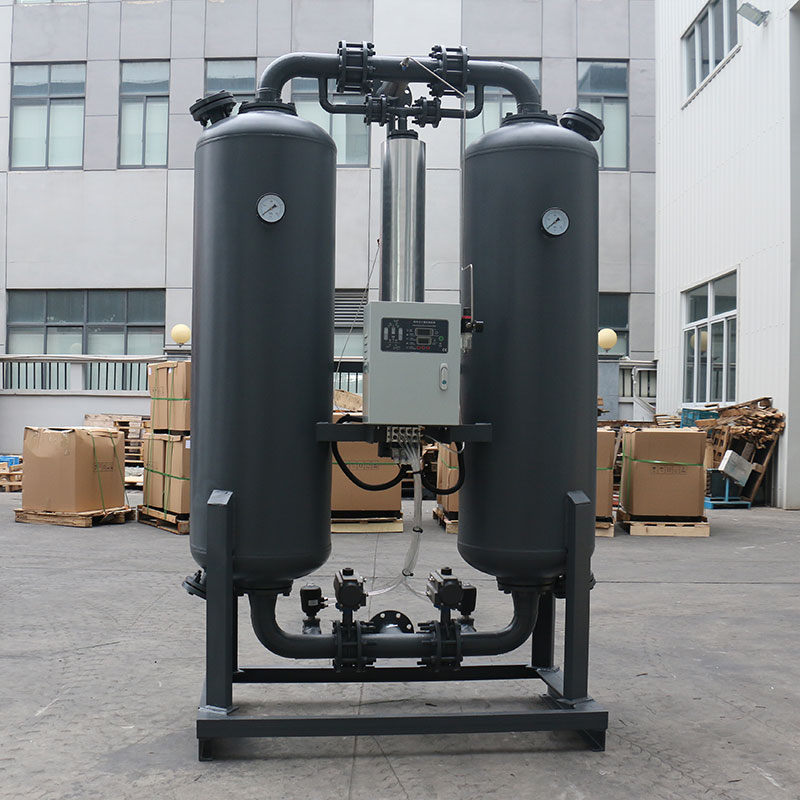| Availability: | |
|---|---|
| Quantity: | |
Micro-heated desiccant dryer is a compressed air drying device that uses adsorbents (such as molecular sieves and silica gel) to remove moisture and utilizes a small amount of heat (lower temperature than traditional heating systems) to assist regeneration, reducing energy consumption while maintaining a low dew point.
Product features
✅ Energy Saving: Uses less gas than heatless regeneration (requires only 5-8% regeneration gas, compared to 15% for heatless regeneration).
✅ Low Dew Point: Suitable for high drying requirements (such as in the pharmaceutical and electronics industries).
✅ Stable Operation: Dual towers operate alternately, providing continuous air supply.
✅ Lower Maintenance Cost: Desiccant life is longer than heatless regeneration.
Technical Parameters
| SRD Series Heated desiccant air dryer | ||||||
| Model | Air Delivery (m3/min) | Voltage (V/HZ) | Power (kW) | Inlet/Outlet (PT) | Dimension (mm) | Weight (Kg) |
| L*W*H | ||||||
| SRD-15 | 17.00 | 380V/50HZ | 5 | DN65 | 1280*820*2360 | 712 |
| SRD-20 | 23.00 | 380V/50HZ | 6 | DN80 | 1400*930*2530 | 848 |
| SRD-25 | 27.00 | 380V/50HZ | 8 | DN80 | 1650*990*2450 | 1150 |
Main Application Areas
Pharmaceutical & Food: Sterile Compressed Air
Electronics: Moisture and Oxidation Prevention
Spraying & Precision Instruments: Preventing Moisture Contamination
Petrochemical & Energy: Instrument Air Drying
FAQ
Q1: Which is more gas-efficient, micro-heating or heatless adsorption?
Micro-heating is more gas-efficient (regeneration gas consumption is lower, and heating improves efficiency).
Q2: What dew point can be achieved?
-40°C to -70°C (better than refrigeration, closer to heatless adsorption).
Q3: How often should the desiccant be replaced?
3-5 years (depending on air quality; replacement is required when the dew point rises).
Q4: Is it suitable for high-temperature environments?
A precooler is required, as adsorbent efficiency decreases at high temperatures.
Q5: Is it more expensive than a refrigerated dryer?
The initial investment is higher, but the long-term energy savings make it suitable for demanding industries.
Micro-heated desiccant dryer is a compressed air drying device that uses adsorbents (such as molecular sieves and silica gel) to remove moisture and utilizes a small amount of heat (lower temperature than traditional heating systems) to assist regeneration, reducing energy consumption while maintaining a low dew point.
Product features
✅ Energy Saving: Uses less gas than heatless regeneration (requires only 5-8% regeneration gas, compared to 15% for heatless regeneration).
✅ Low Dew Point: Suitable for high drying requirements (such as in the pharmaceutical and electronics industries).
✅ Stable Operation: Dual towers operate alternately, providing continuous air supply.
✅ Lower Maintenance Cost: Desiccant life is longer than heatless regeneration.
Technical Parameters
| SRD Series Heated desiccant air dryer | ||||||
| Model | Air Delivery (m3/min) | Voltage (V/HZ) | Power (kW) | Inlet/Outlet (PT) | Dimension (mm) | Weight (Kg) |
| L*W*H | ||||||
| SRD-15 | 17.00 | 380V/50HZ | 5 | DN65 | 1280*820*2360 | 712 |
| SRD-20 | 23.00 | 380V/50HZ | 6 | DN80 | 1400*930*2530 | 848 |
| SRD-25 | 27.00 | 380V/50HZ | 8 | DN80 | 1650*990*2450 | 1150 |
Main Application Areas
Pharmaceutical & Food: Sterile Compressed Air
Electronics: Moisture and Oxidation Prevention
Spraying & Precision Instruments: Preventing Moisture Contamination
Petrochemical & Energy: Instrument Air Drying
FAQ
Q1: Which is more gas-efficient, micro-heating or heatless adsorption?
Micro-heating is more gas-efficient (regeneration gas consumption is lower, and heating improves efficiency).
Q2: What dew point can be achieved?
-40°C to -70°C (better than refrigeration, closer to heatless adsorption).
Q3: How often should the desiccant be replaced?
3-5 years (depending on air quality; replacement is required when the dew point rises).
Q4: Is it suitable for high-temperature environments?
A precooler is required, as adsorbent efficiency decreases at high temperatures.
Q5: Is it more expensive than a refrigerated dryer?
The initial investment is higher, but the long-term energy savings make it suitable for demanding industries.